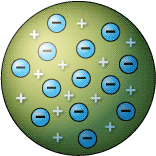| |
 |
| The 'Plum Pudding' model of the atom.
Negatively charged electrons (the plums) are embedded
in a sphere of uniform positive charge (the pudding). |
|
|
|
The first
model of the atom was developed by J.J. Thomson and Lord
Kelvin in 1904. They called it the 'plum pudding' model
because the negative electrons (the plums) were embedded
in a sphere of uniform positive charge (the pudding). This
model was soon replaced. In 1911, Ernest Rutherford suggested
that his students Geiger and Marsden fire alpha particles
(produced by some naturally radioactive materials) at a
thin gold foil. They observed that some of the alpha particles
were scattered through large angles, indicating that the
positive charge in the atom was concentrated in a small
volume – the nucleus. Rutherford subsequently proposed
a model of atom based on a central nucleus of positive charge
circled by negative electrons – like planets orbiting
the sun. Rutherford was awarded the Nobel Prize in Chemistry
in 1908 for his work on understanding radioactive decay. |